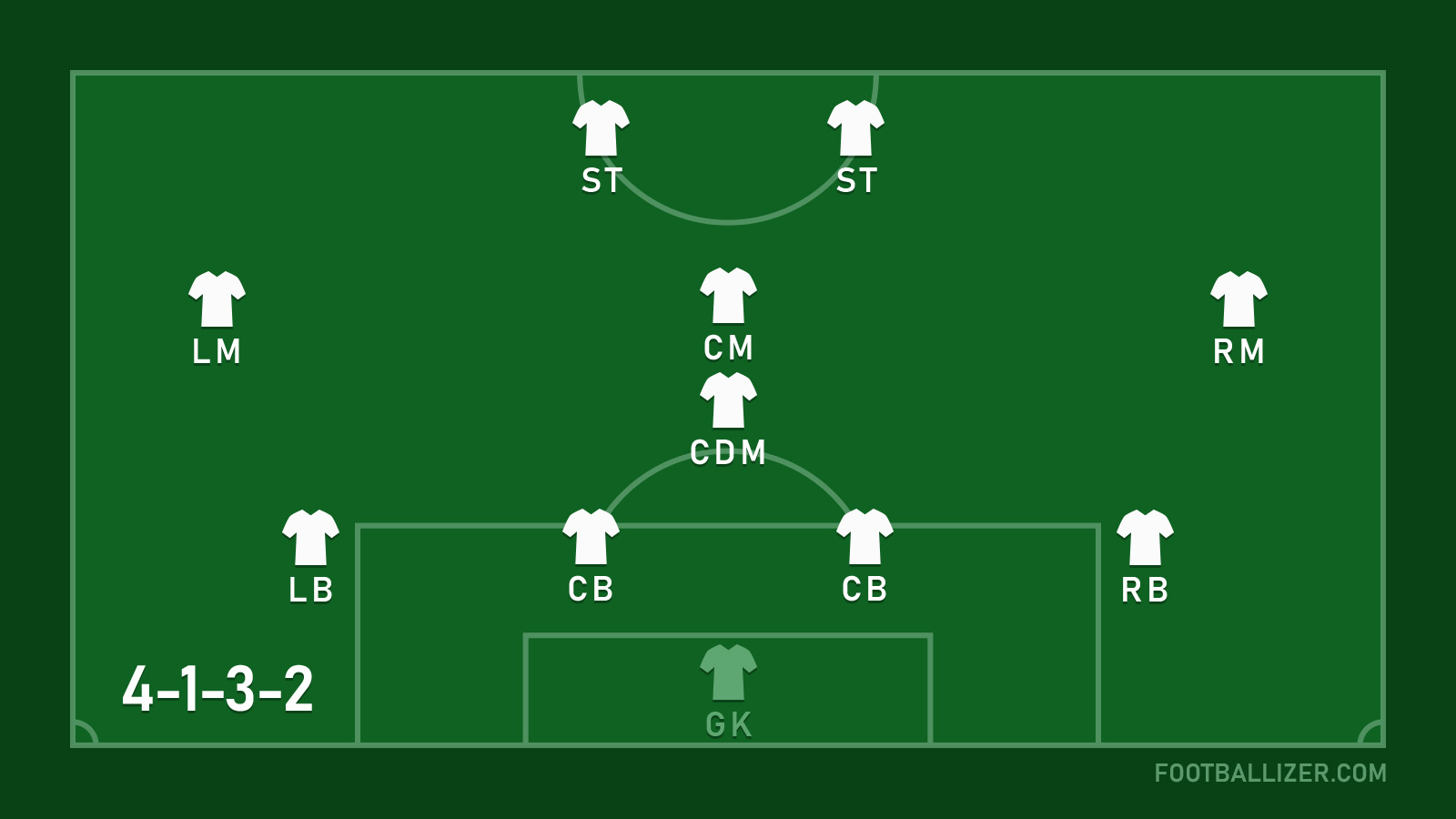4-1-3-2 Formation

The 4-1-3-2 formation is known as the "diamond" or "rhombus" formation, consists of four defenders, one defensive midfielder, three attacking midfielders, and two forwards.
This formation emphasizes a balance between defense and attack, with a strong midfield presence that can control the flow of the game and create scoring opportunities for the forwards. It requires disciplined positioning and effective communication between players, as well as a good understanding of both attacking and defending principles. Following is a description of each position:
- Four defenders: These players are typically split into two center backs and two fullbacks. Their main objective is to defend their own half of the field and prevent the opposing team from scoring.
- One defensive midfielder: This player is positioned just in front of the back four, and their primary responsibility is to shield the defense and prevent the opposition from advancing into dangerous positions. They may also be involved in initiating attacking moves by distributing the ball to the midfielders or forwards.
- Three attacking midfielders: These players are typically split into a central attacking midfielder and two wingers. Their primary objective is to create scoring opportunities for the two forwards, as well as score goals themselves if possible. They may also be involved in defensive duties, such as pressing the opposition when they have possession.
- Two forwards: These players are responsible for scoring goals and creating chances for themselves and their teammates. They may be split into a target striker and a second striker, with the former being more physical and the latter being more mobile.
Pros
Strong Midfield Line
The diamond shape of the midfield allows for a compact and dynamic midfield presence, which can control the game by dictating the tempo and creating scoring opportunities for the forwards.
Flexibility
The formation can be adjusted to suit the team's strengths and weaknesses. For example, the attacking midfielders can be instructed to play more defensively if the team is facing a strong opponent.
Balanced Attacking Options
With two forwards and three attacking midfielders, the team has multiple attacking options that can create scoring opportunities from different areas of the field.
Defensive Stability
The lone defensive midfielder provides a solid shield in front of the back four, which can help prevent counterattacks and limit the opposition's scoring chances.
Counterattack Opportunities
With a strong midfield presence and quick forwards, the team can launch quick counterattacks to catch the opposition off-guard and score goals.
Partnership Between Strikers
The diamond formation often employs two strikers playing as a partnership, which can create a strong attacking threat and make it difficult for the opposition defense to mark both players effectively.
Cons
Deficiency on the Sides
Vulnerability on the flanks: With only two wide players (the fullbacks), the team can be vulnerable to attacks down the flanks, especially against teams that play with wide wingers. Lack of defensive cover: If the lone defensive midfielder is caught out of position, the back four can be left exposed to counterattacks.
Need for Disciplined Midfielders
The three attacking midfielders need to be disciplined in their positioning and defensive duties, otherwise the team may be vulnerable to counterattacks.
Limited Attacking Options
If the team is unable to create scoring opportunities through the midfield or on the flanks, the forwards may become isolated and struggle to score goals.
Reliance on Individual Performances
The success of the formation can depend heavily on the individual performances of the players, particularly the attacking midfielders and forwards.
How to Counter 4-1-2-1-2 Formation?
There are several strategies that teams can use in order to counter the 4-1-3-2 formation:
Exploit the sides: As mentioned earlier, the formation can be vulnerable on the flanks, so teams can look to attack down the wings and deliver crosses into the box to create scoring opportunities.
Press the defensive midfielder: The lone defensive midfielder is crucial to the formation's defensive stability, so teams can try to press them and force turnovers in midfield.
Pack the midfield: By crowding the midfield and denying space to the attacking midfielders, teams can disrupt the formation's attacking rhythm and limit their ability to create scoring opportunities.
Play with wide wingers: By playing with wingers who can stretch the opposition's defense and create overloads on the flanks, teams can create space for their midfielders and forwards to exploit.
Counterattack quickly: This formation can be vulnerable to quick counterattacks, especially if the attacking midfielders are caught out of position, so teams can look to launch fast breakaways to catch the opposition off-guard.
Use a formation with three central midfielders: By matching the formation with three central midfielders, teams can match the midfield battle and deny space to the attacking midfielders.